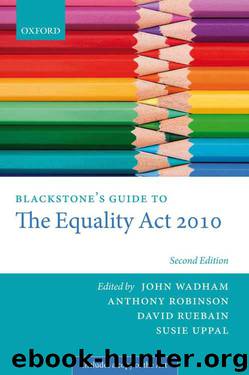Blackstone's Guide to the Equality Act 2010 (Blackstone's Guides) by John Wadham & Anthony Robinson & David Ruebain & Susie Uppal

Author:John Wadham & Anthony Robinson & David Ruebain & Susie Uppal [Wadham, John]
Language: eng
Format: epub, mobi
Tags: Second Edition
Publisher: Oxford University Press
Published: 2012-05-16T21:00:00+00:00
4. Article 14: the Right to Non-discrimination
(a) The Developing Importance of Article 14
12.81
The right to equality and non-discrimination is a fundamental human right recognized in many international human rights treaties123 and equality of treatment has been recognized as ‘one of the building blocks of democracy’.124 Article 14 seeks to ensure that all persons are able to enjoy the rights under the ECHR without discrimination. As a result, Article 14 is a key provision of the ECHR and, given its links with domestic discrimination law, it is vital to appreciate how it interacts with discrimination law.
12.82
It should be recognized that the importance of Article 14 has evolved and enhanced over time. For a considerable period the case law in the ECtHR on Article 14 was undeveloped and provided a narrow interpretation of certain concepts of discrimination, such as indirect discrimination. One of the reasons for this was that in the past the ECtHR took the approach that if it found a breach of a substantive right, it was unnecessary to go on to consider whether there had been a breach of Article 14. In Airey v Ireland the court found that where a violation of a substantive provision is found, further examination of Article 14 is ‘not generally required’ unless ‘a clear inequality of treatment in the enjoyment of the rights in question is a fundamental aspect of the case’.125 In Dudgeon v UK the ECtHR went further, stating that examining Article 14 once a violation of a substantive provision had been found served ‘no useful purpose’.126 As a result, although the Court found a breach of Article 8 in respect of private life, it found it unnecessary to consider whether there was discrimination on grounds of sexual orientation. This approach has been criticized by a number of judges and commentators.127
12.83
More recently the ECtHR has taken a more expansive and progressive approach to the consideration of Article 14 claims generally and to its interpretation of concepts of discrimination.128 In the landmark decision DH v Czech Republic, the Grand Chamber substantially broadened the interpretation of indirect discrimination before the ECtHR and relied on the EU Equality Directives in analysing discrimination concepts. This constitutes a movement towards further harmonization of discrimination concepts between the EU and the ECHR.129
Download
Blackstone's Guide to the Equality Act 2010 (Blackstone's Guides) by John Wadham & Anthony Robinson & David Ruebain & Susie Uppal.mobi
This site does not store any files on its server. We only index and link to content provided by other sites. Please contact the content providers to delete copyright contents if any and email us, we'll remove relevant links or contents immediately.
| Air & Space | Construction |
| Disability | Educational Law & Legislation |
| Labor Law | Maritime |
| Military | Personal Injury |
| Sports |
Steroids: History, Science, and Issues by Standora Joan E.; Bogomolnik Alex; Slugocki Malgorzata(1195)
A Practical Guide to International Arbitration in London by Hilary Heilbron(1085)
Adrift by Steven Callahan(1033)
Reclaiming History by Vincent Bugliosi(1021)
Persuasion by Owner(1014)
The Nuremberg Interviews by Leon Goldensohn(991)
Dog Company: A True Story of American Soldiers Abandoned by Their High Command by Lynn Vincent & Roger Hill(980)
40 Days and 40 Nights by Matthew Chapman(969)
Poisoned by Jeff Benedict(960)
Last Narco by Beith Malcolm(936)
The New Whistleblower's Handbook by Stephen Kohn(921)
Introduction to the study and practice of law in a nutshell by Kenney F. Hegland(897)
Kafka's Last Trial by Benjamin Balint(849)
Lincoln's Code by John Fabian Witt(843)
A Passing Fury by A. T. Williams(826)
Japanese War Crimes during World War II: Atrocity and the Psychology of Collective Violence by Frank Jacob(812)
Eichmann in Jerusalem by Hannah Arendt(801)
Dog Company: A True Story of American Soldiers Abandoned by Their High Command by Roger Hill & Lynn Vincent(795)
A Court of Refuge by Ginger Lerner-Wren & Rebecca A. Eckland(786)
